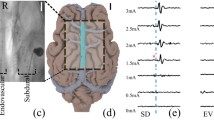Abstract
The literature pertaining to epidural-pressure measurement gives the impression that, with the use of coplanar transducers, errors due to dural bending are minimised and an epidural-pressure equivalent to the ventricular fluid pressure is obtained. By means of a simple theoretical analysis, it has been shown that, for chronic implantation measurements, coplanar systems do not have any special advantages over noncoplanar systems because both are subject to errors due to tissue compressive stresses of magnitudes considerably greater than the dural bending stresses. Therefore the considerably simpler noncoplanar transducers, together with a special approach toin vivo calibration, are adequate if they are of a form which selectively responds to c.s.f. pressure more than to tissue stresses. The conventional circular-diaphragm transducer does not satisfy the requirement. This limitation can be circumvented by reducing the deflection constraints. A new design proposed has the special feature that it responds directly to c.s.f. pressure, even though immediately over the transducer face the subarachnoid space is obliterated Model as well as animal experiments substantiate the claim. Simultaneous measurements with the new transducer and a direct c.s.f. pressure transducer show that the c.s.f. pressure changes are correctly indicated by the new transducer.
Similar content being viewed by others
References
De Jong, D. A., Den Ouden, A. H., Van De Boon, A., Eijskoot, F. andMaas, A. (1975) Telemetered epidural pressure.Biotelemetry,2, 257–264.
Hakim, S., Venegas, J. G. andBurton, J. D. (1976) The physics of the cranial cavity; hydrocephalus and normal pressure hydrocephalus: mechanical interpretation and mathematical model.Surg. Neurol.,6, 187–207.
Jorgensen, P. B. andRishede, J. (1972) Comparative clinical studies of epidural and ventricular pressure.InBrock, M. andDietz, H. (Eds.),Intracranial pressure, Springer-Verlag, Berlin, 41–45.
Mackay, R. S. (1964) The application of physical transducers to intracavity pressure measurement with special reference to tonometry.Med. Electron. Biol. Eng.,2, 13–19.
Majors, R., Schettini, A., Mahig, J. andNevis, A. H. (1972) Intracranial pressures measured with the coplanar pressure transducer.Med. Biol. Eng.,10, 724–733.
Nornes, H. andSerck-Hanssen, F. (1970) Miniature transducer for intracranial pressure monitoring in man.Arch. Neurol. Scand.,46, 203–214.
Roark, R. J. (1965)Formulas for stress and strain McGraw-Hill, Tokyo, 298–308.
Sundbarg, G. andNornes, H. (1972) Simultaneous recording of epidural and ventricular fluid pressure.InBrock, M. andDietz, H. (Eds.),Intracranial pressure, Springer-Verlag, Berlin, 46–50.
Author information
Authors and Affiliations
Rights and permissions
About this article
Cite this article
Guha, S.K., Anand, S. & Tandon, P.N. New epidural intracranial-pressure transducer with reduced tissue stress interference. Med. Biol. Eng. Comput. 17, 757–762 (1979). https://doi.org/10.1007/BF02441558
Received:
Accepted:
Issue Date:
DOI: https://doi.org/10.1007/BF02441558




